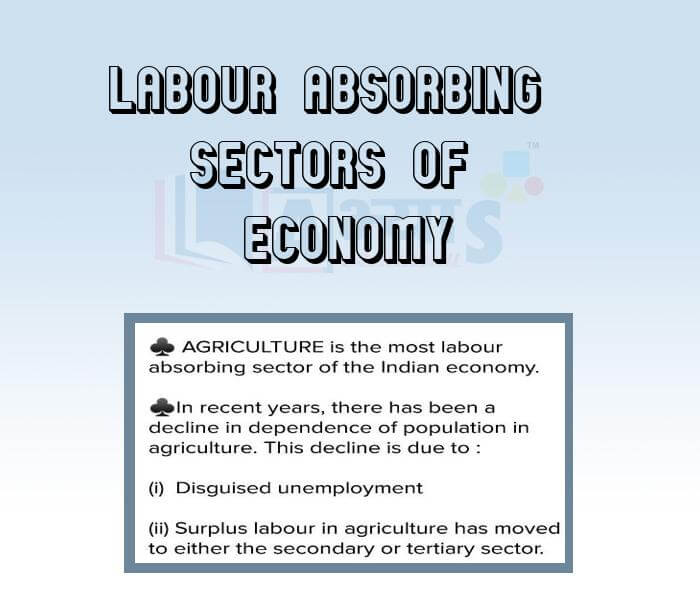Labour Absorbing Sectors of Economy













Labour Absorbing Sectors of Economy
Labour Absorbing Sectors of Economy: Although agriculture is the most-labour absorbing sector of the economy, employment in this sector has declined because of disguised unemployment. The surplus people have moved to work in the Secondary and Tertiary sectors. Small-scale manufacturing absorbs most of the labour in the Secondary sector. New employment opportunities are emerging in the Tertiary sector in IT, biotechnology call centres and other service areas.
Story of a Village: How Education Created Employment: There was a village inhabited by several families. Each family produced enough to feed its members. Each family met its needs by the members making their own clothes and teaching their own children. One of the families decided to send one of its Sons to an agricultural college. The boy got his admission in the nearby college of agriculture. After some time, he became qualified in agro-engineering and came back to the village. He proved to be so creative that he could design an improved type of plough, which increased the yield of wheat. Thus, a new job of agro-engineer was created and filled in the village. The family in the village sold the surplus in a neighbouring village. They earned good profit, which they shared among themselves. Inspired by this success, all the families after some time held a meeting in the village. They all wanted to have a better future for their children too. They requested the Panchayat to open a school in the village. They assured the Panchayat that they would all send their children to school. The Panchayat, with the help of government, opened a school. A teacher was recruited from a nearby town. All the children of this village started going to school. After some time, one of the families gave training to their daughter in tailoring. She started stitching clothes for all the families of the village. Everyone now wanted to buy and wear well-tailored clothes. Thus, another new job, of a tailor, was created. This had another positive effect. The time of the farmers in going far for buying clothes was saved. As the farmers spent more time in the field, the yield of the farms went up. This was the beginning of prosperity. The farmers had more than what they could consume. Now they could sell what they produced to others who came to their village markets. This was the story of a simple village where the rising level of human capital enabled it to evolve into a place rich with complex and modern economic activities.
Observations and Conclusions from the Story:
1. New jobs like agro-engineer, tailor etc are created and filled in the village.
2. By adopting the new ideas, villagers increased their production and earned good profit, which they shared among themselves,
3. Villagers started thinking of a better future for their children too.
Over time, this village, which had no job opportunities in the beginning, developed many jobs like teacher, tailor agro-engineer etc.
Students / Parents Reviews [10]
A marvelous experience with Abhyas. I am glad to share that my ward has achieved more than enough at the Ambala ABHYAS centre. Years have passed on and more and more he has gained. May the centre flourish and develop day by day by the grace of God.

Archit Segal
7thOne of the best institutes to develope a child interest in studies.Provides SST and English knowledge also unlike other institutes. Teachers are co operative and friendly online tests andPPT develope practical knowledge also.

Aman Kumar Shrivastava
10thIt was a good experience with Abhyas Academy. I even faced problems in starting but slowly and steadily overcomed. Especially reasoning classes helped me a lot.

Cheshta
10thIt has a great methodology. Students here can get analysis to their test quickly.We can learn easily through PPTs and the testing methods are good. We know that where we have to practice

Barkha Arora
10thBeing a parent, I saw my daughter improvement in her studies by seeing a good result in all day to day compititive exam TMO, NSO, IEO etc and as well as studies. I have got a fruitful result from my daughter.

Prisha Gupta
8thMy experience was very good with Abhyas academy. I am studying here from 6th class and I am satisfied by its results in my life. I improved a lot here ahead of school syllabus.

Ayan Ghosh
8thIt was good as the experience because as we had come here we had been improved in a such envirnment created here.Extra is taught which is beneficial for future.

Eshan Arora
8thAbhyas Methodology is very good. It is based on according to student and each child manages accordingly to its properly. Methodology has improved the abilities of students to shine them in future.

Manish Kumar
10thMy experience with Abhyas academy is very good. I did not think that my every subject coming here will be so strong. The main thing is that the online tests had made me learn here more things.

Hiya Gupta
8thAbout Abhyas metholodology the teachers are very nice and hardworking toward students.The Centre Head Mrs Anu Sethi is also a brilliant teacher.Abhyas has taught me how to overcome problems and has always taken my doubts and suppoeted me.
